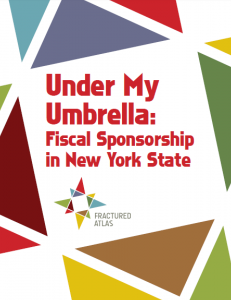By Ian David Moss on January 27th, 2014
Two New Research Publications from Fractured Atlas
A couple of years ago, we redesigned our fiscal sponsorship annual report to match up more closely with the format of the Cultural Data Project, an emerging data standard for cataloging financial, operational and programmatic information relating to arts nonprofits. In September 2012, we reaped the first fruits of that evolution in the form of “Discovering Fiscally Sponsored NYC Dancemakers,” a research report conducted for Dance/NYC that was the first study we know of to combine data from multiple fiscal sponsors to paint an inclusive picture of the dance community.
This past summer and fall, we were able to complete two more studies using our fiscal sponsorship data with the help of Research Fellow Sarah Lenigan, who served as lead author on both reports.

First, we continued our partnership with Dance/NYC to create “State of NYC Dance 2013,” a sequel of sorts to the service organization’s original snapshot of the city’s dance community published in 2011. “State of NYC Dance 2013” builds on previous Dance/NYC and Fractured Atlas research to present trend data, covering a time when the arts sector was dealing with the aftereffects of the worst economic recession in 70 years. We were also able to integrate a sample of our awesome fiscal sponsees, for the first time, into Dance/NYC’s primary analysis of the sector. Study findings offer a heartening story of growth in challenging times. From 2009 to 2011, performances increased 3% and live attendance grew 12%, and we saw the first instances of paid “virtual” attendance, a new form of revenue for dance groups. Nonprofit dance makers also generated gains in foundation contributions and special events, and created new jobs, though the majority of these were part-time. We also discovered that in contrast to nonprofits which were mostly concentrated in Manhattan, 47% of the sponsored dance makers in the study were headquartered in Brooklyn, and 15% in Queens.

Our other report was commissioned by the Arts & Culture Research Fund, administered by the New York Community Trust. The objective of “Under My Umbrella: Fiscal Sponsorship in New York State” was to better understand fiscal sponsorship’s relationship to and place within the arts ecosystem, using the most recent year available of CDP and Fractured Atlas fiscal sponsorship data. Our core research question was whether, controlling for other factors, fiscally sponsored status predicts specific relevant organizational characteristics such as earned income, total attendance, and fundraising efficiency.
So what did we find? For the most part, the answer to the question is no, it doesn’t. By far the largest factor in all of these analyses was sheer size — not surprisingly, if you’re a bigger organization you have more attendees, and so forth. Fiscal sponsorship was not among the most important factors driving outcomes like attendance, occupancy expense, or the proportion of expenses going to programs. There was one pretty significant effect, though — a sponsored project was likely to have a much greater percentage of its revenue coming from earned income compared to a nonprofit of similar size, location, and discipline. This opens up a range of possible directions for future inquiry — are sponsored projects earning more of their income by choice, because they’re entrepreneurial like that, or is it out of necessity, because some funders won’t make grants to fiscal sponsors? We’d love to hear your thoughts.
Another finding that we weren’t necessarily looking for, but that is nevertheless of interest, is how differently organizations and sponsored projects alike are structured by discipline. For example, holding other factors constant, theater groups reported lower attendance (total year-round, free + paid) than entities in other disciplines, and music organizations and projects spent less on occupancy (space and office rental, etc.) than their peers. We recommend that future research efforts be careful to separate arts organizations and sponsored projects out by discipline given the numerous statistically significant discipline effects we observed.
“Under My Umbrella” admittedly isn’t the lightest reading, since the analyses we were conducting are a little more technically ambitious than your typical arts research effort and we wanted to be sure the statheads amongst us could follow along. There’s a good reason for that technical language, though. This is the first research report to explore the potential of regression analysis to understand the differences between nonprofits and fiscally sponsored projects using data from the Cultural Data Project, and one of the first to use regression in connection with the CDP more generally. Previous research in this area for the most part hasn’t accounted for the interaction of factors like budget size, location, discipline, etc. with each other. For example, small-budget organizations are obviously different from big-budget organizations, but small-budget big city organizations may similarly have little in common with small-budget organizations in rural areas. What regression does is isolate these factors from each other so that they can be examined individually. It allows us to answer the question, how much of an impact does budget size (or any other variable of interest) have, all else being equal?
Adding fiscal sponsorship status to this mix, in turn, enables us to answer some important questions about fiscal sponsorship. To date, our sector has operated mostly in the dark about how sponsored projects differ from nonprofits in the aggregate, and what little insight has been available to us has been limited by the fact that sponsored projects tend to be smaller than nonprofits on average. Are the differences we’re seeing simply a product of that small size, or is there something specific about being a sponsored project that is causing them? This study empowers us to start exploring that question.
Many thanks to all of Fractured Atlas’s fiscal sponsees for making these reports possible!
About Ian David Moss
Ian David Moss was the Senior Director of Information Strategy at Fractured Atlas, a nonprofit technology company that helps artists with the business aspects of their work. To learn more about Fractured Atlas, or to get involved, visit us here.

